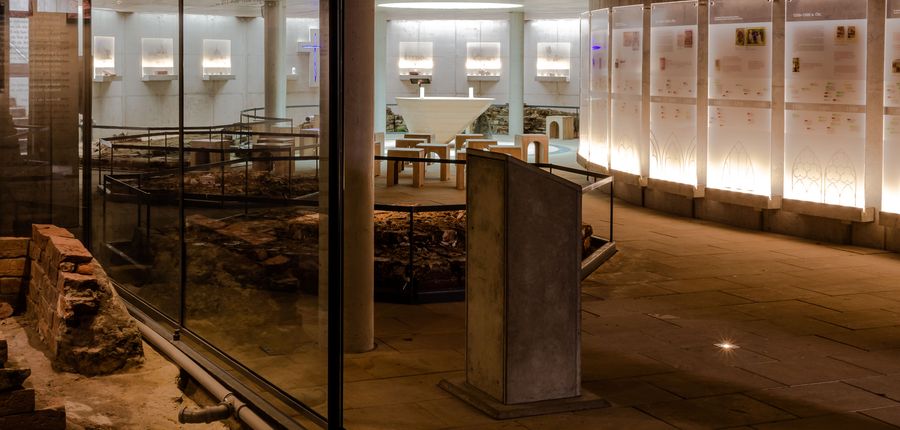The room of the search for clues
Through light, text and sounds, visitors can be guided through the semi-underground space in their search for clues.

Through light, text and sounds, visitors can be guided through the semi-underground space in their search for clues.
From the field of medieval archaeology to the brick boxes (graves) framed in glass to the relics of other sunken East Frisian monasteries. Numerous excavation finds of recent years can be seen in the room of the search for clues. These include, among other things, the Ihlow tiles: floor slabs with depictions of lions, eagles and mythical creatures, which were probably laid in the sanctuary of the former monastery church.
The exhibition in the Room of the Search for Clues was created in 2008. Visitors can experience the historical and spiritual dimension of the Ihlow Monastery, its history and future.
Holger Freiherr von Neuhoff, director and author, developed the exhibition concept with his team: "In our accelerated time, we need more than ever resting points that make us aware of the cultural identity that surrounds us. If we, as sustainable networkers, place our very own history in the cultural European context and learn to understand it, this can enrich us all," says Holger von Neuhoff.
The sound installation in the Raum der Spurensuche - a sound painting, created especially for this place - comes from the composer Christopher von Deylen ("Musikprojekt Schiller").
A special exhibit of the exhibition in the room of the search for clues is the "timeline":
17 panels with the history of world religion on a semi-circular wall. Embedded in it is data of the Frisian history. The "timeline" ranges from the Last Supper of Jesus in Jerusalem to the erection of the first vaulted arch of the Ihlow monastery church imagination on 25 September 2008.
The tour through the room of the search for clues moves towards the new Ihlow altar. It is located under the former main altar of the monastery church, only one and a half meters lower. Therefore three arm's lengths under those burnt floor slabs over which the priestly monks of the "School of God" celebrated the Lord's Supper, and where the medieval carved altar stretched its side wings into the church interior. Incidentally, this is the only work of art from the Ihlow monastery church that has been preserved. During the destruction of the church in the first third of the 16th century, it was transferred to Aurich. It has found its new home in the Lambertikirche in the heart of the district town.
The new Ihlow altar consists of a circular table supported by a bronze sculpture. This reproduces the fragment of a stone slab with a consecration cross, which was found during excavations at the monastery site.
The carved consecration cross suggests that it is the corner of a medieval altarpiece.
"My simple basic idea when I designed the altar was: the old always supports the new," Gunther Gerlach describes the idea for his master table made of beech wood. The Bremen sculptor was identified as part of an artist competition in 2006, which was significantly supported by the Hanns Lilje Foundation (Hanover).
The new Ihlow altar is a sign of today's events at the Ihlow monastery site: Beyond memory, without the search for traces in the past, the present stands on uncertain feet, and would easily falter.
The "Ihlow Prayer"
From spring to late autumn, a prayer service takes place every Friday from 5.00 p.m. in the room of the search for clues.